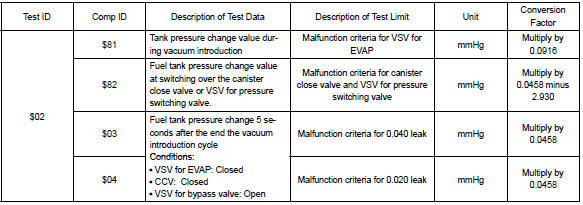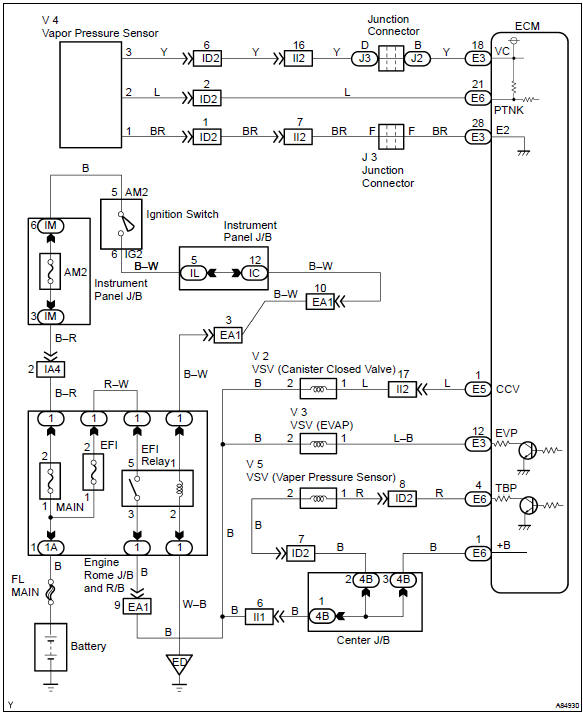Toyota Corolla (E120) 2002–2008 Repair Manual / Diagnostics / Sfi system / Evaporative emission control
system / Circuit description
Toyota Corolla (E120): Circuit description
The vapor pressure sensor, vsv for canister closed valve (ccv), vsv for pressure switching valve are used to detect abnormalities in the evaporative emission control system.
The ecm decides whether there is an abnormality in the evaporative emission control system based on the vapor pressure sensor signal.
Dtcs p0441 and p0446 are recorded by the ecm when evaporative emissions leak from the components within the dotted line in fig. 1 Below, or when there is malfunction in both vsv for evap and vsv for pressure switching valve, or in the vapor pressure sensor itself.


Hint
: typical dtc output of each trouble part.

*1: Ecm may output some other dtcs combination.
*2: Refer to p0442 and p0456.
Monitor description
P0441
The ecm checks for a stuck closed malfunction in the vsv for evap by commanding it to open with the ccv closed. If a high negative pressure does not develop inthe fuel tank, the ecm determines that the vsv for evap remains closed. The ecm turns on the mil and a dtc is set.
The ecm checks for vsv for evap ”stuck open” fault by commanding both valves (vsv for evap and ccv) to close at a time when the fuel tank is at atmospheric pressure. If the fuel tank develops a high negative pressure at this early stage of the test, the ecm determines that the vsv for evap is stuck open.
The ecm will turn on the mil and a dtc is set.
P0446
If there is a malfunction detected in the vsv for evaporative emission (evap), the canister closed valve (ccv) and the vsv for bypass valve; the ecm will illuminate the mil and set a dtc.
This portion of the evap diagnosis checks the following evap system functions:
- ccv stuck closed.
The ecm checks for a ccv ”stuck closed” malfunction by commanding the ccv to open after an evap leak test. If the fuel tank pressure does not rise (lose vacuum), the ecm determines that the ccv is stuck closed. The ecm will turn on the mil and a dtc is set.
- vsv for pressure switching valve stuck closed.
The ecm checks for a vsv for pressure switching valve ”stuck closed” malfunction by commanding the vsv for pressure switching valve to close after an evap leak test. If the fuel tank pressure does not change, the ecm determines that the vsv for pressure switching valve is malfunctioning. The ecm will turn on the mil and a dtc is set.
- vsv for evap (purge line to intake manifold) stuck closed.
The ecm checks for a stuck closed malfunction in the vsv for evap by commanding it to open with the ccv closed. If a high negative pressure does not develop inthe fuel tank, the ecm determines that the vsv for evap remains closed. The ecm turns on the mil and a dtc is set.
Monitor strategy

Typical enabling conditions

Typical malfunction thresholds
P0441

P0446

Monitor result (mode 06 data)

Refer for the detailed information on checking monitor status.
Wiring diagram

Other materials:
Rear axle lh hub bolt
Replacement
Hint: components:
1. Remove rear wheel
2. Remove rear brake drum sub–assy
3. Remove rear axle lh hub bolt
Using sst and a hammer handle or an equivalent, remove
the lh hub bolt.
Sst 09628–10011
4. Install rear axle lh hub bolt
Install a washer and nut to a ...
Displaying the device status
Select “Bluetooth* info” using .
● Displaying the device name
Select “Device Name” using .
● Displaying the device address
Select “Device Address” using .
*: Bluetooth is a registered trademark of Bluetooth SIG, Inc. ...
On–vehicle inspection
1. Inspect speedometer
check the operation.
Using a speedometer tester, inspect the speedometer fro allowable
indication error and check
the operation of the odometer.
Reference:
Notice:
tire wear and tire over or under inflation will increase the indication error.
...


